It is not uncommon to see a snake when you are in nature or sometimes, even in your backyard. Snakes come in a variety of colors. Brown and tan are the most common colors, but some snakes have orange coloration.
If you have recently seen an orange snake and you are trying to identify it, continue reading below. We have listed the most common orange snakes you may encounter.
Table of Contents
Are Orange Snakes Venomous?
Orange snakes can be venomous or non-venomous. The orange coloration does not automatically mean the snake you have encountered is dangerous to humans.
The one to watch for is the red diamond rattlesnake. While it is the least venomous of all the rattlesnakes, it is still considered a medical emergency. If you do happen to encounter the red diamond rattlesnake and it bites you, seek urgent medical treatment for anti-venom.
A bite from the red diamond rattlesnake can cause pain and swell in the bite location. You may also experience excessive bleeding, nausea, and swelling in your throat and mouth. Some people are known to go into shock. Do not wait for symptoms to get worse, head straight to the hospital for immediate treatment.
Types of Orange Snakes
There is a variety of orange snakes, these include:
1. Ring-necked Snake
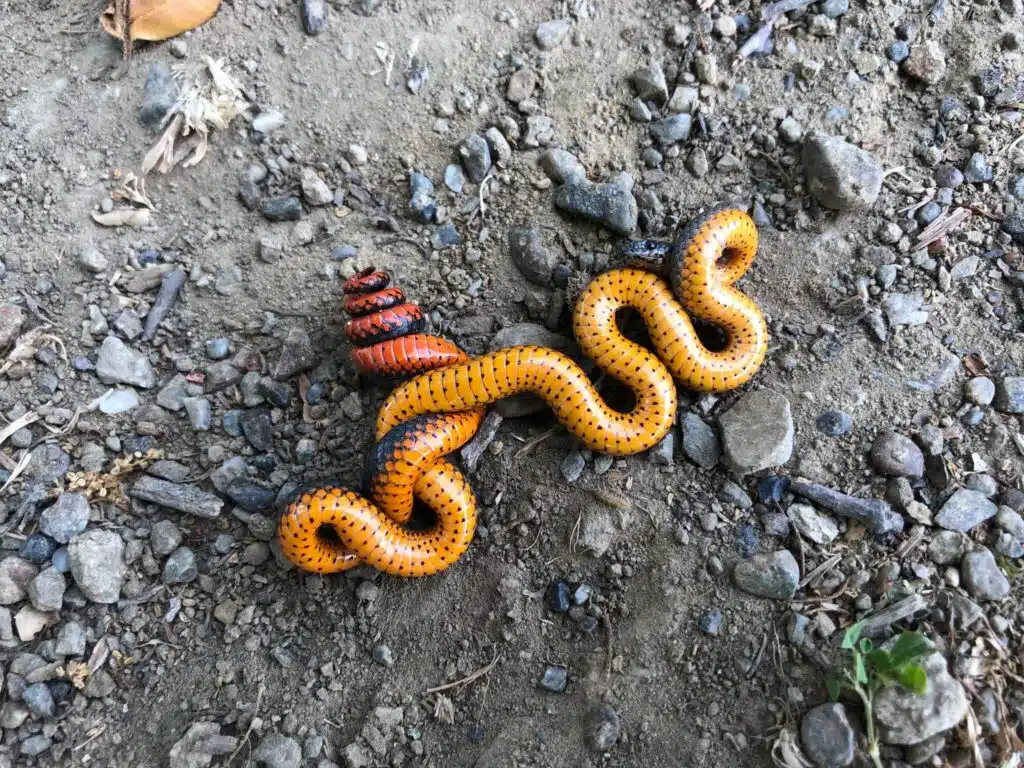
The Ring-necked Snake (Diadophis punctatus) is completely harmless and common throughout the United States. These are nocturnal and secretive snakes. They are not often seen during the day, so chances are you won’t encounter them unless you are out at night.
This snake is known for its defense posture. It will curl its tail, exposing its bright orange-red posterior when threatened. It is an abundant snake throughout its range.
You can identify this snake easily with its brown, blue-gray, olive back and an orange-yellow, yellow, or red neckband. Some have reduced neckbands. Some of the ring-necked snakes have cream neckbands. The head is darker than the body.
The underside of the snake is orange-yellow to red with crescent-shaped black spots. They can grow to thirty-eight centimeters in length with juveniles, measuring around twenty centimeters. The scales are smooth.
The male has small tubercles on the scales. This snake is very common throughout the United States, central Mexico, and southeastern Canada. They are harmless to humans but do have weak venom that is used to subdue their prey, including amphibians, small snakes, and lizards.
2. Red-bellied Snake
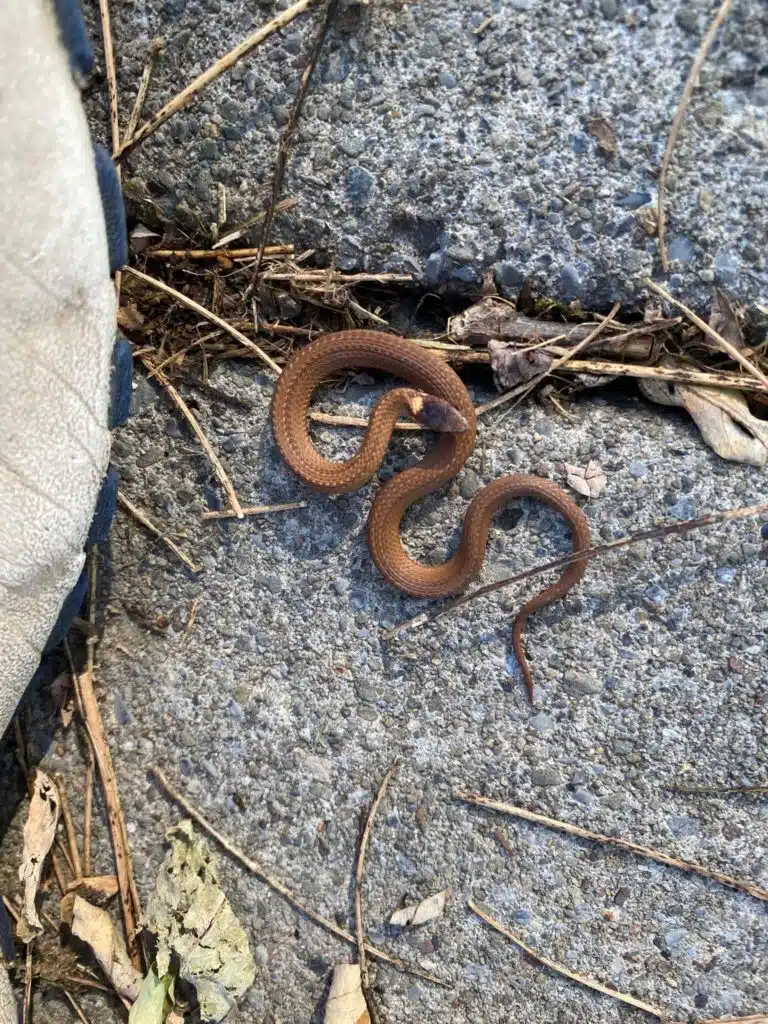
The Red-bellied Snake (Storeria occipitomaculata) is also known as the red belly snake, common in North America. This small snake is a woodland species, that can grow to twenty-five centimeters in length. The colors vary from brown or black, to gray or orange. They have a bright orange underbelly.
This non-venomous snake can be encountered in warm habitats, where it inhabits abandoned ant mounts. The abandoned ant mounts absorb solar radiation, they are also insulated, which provides a warm and comfortable home for the snake.
This snake has large eyes. The reason they choose the abandoned ant mounts is they cannot burrow on their own. They are sometimes encountered under leaf debris and logs.
3. Corn Snake
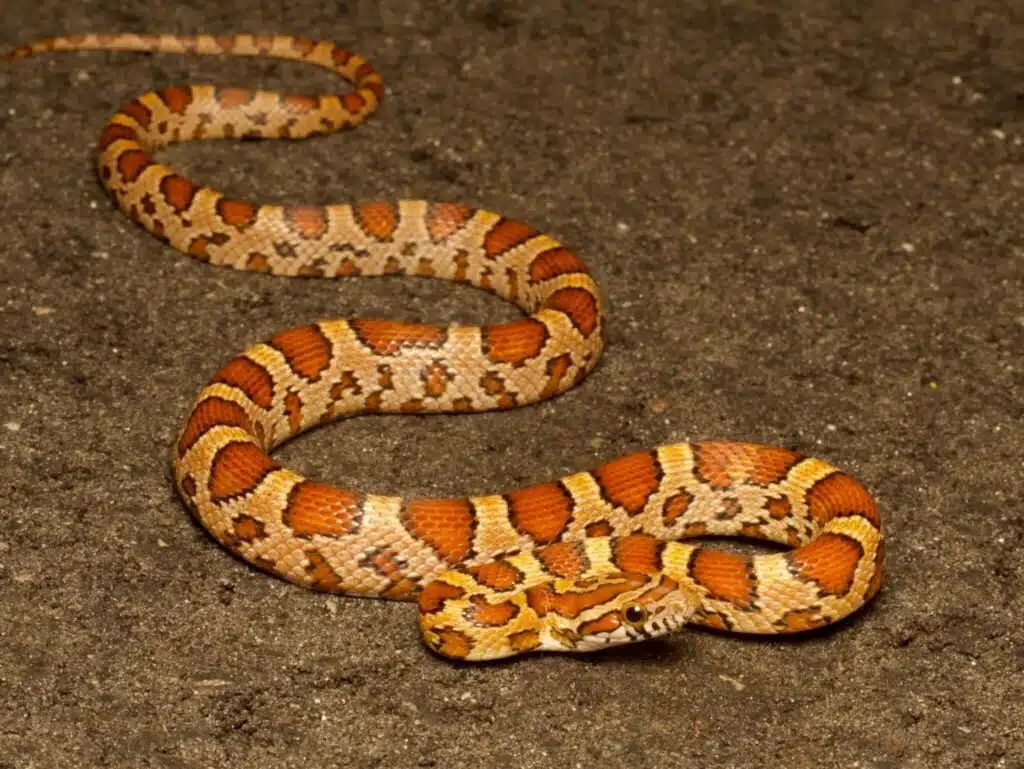
Corn Snakes (Pantherophis guttatus) are North American rat snakes, belonging to the Colubridae family. The snake subdues its prey by constriction. They are commonly seen in the central and southeastern United States.
The corn snake resembles the copperhead, which is a venomous snake. As a result, they are often killed as they are mistaken as a dangerous copperhead. The corn snake does not have functional venom and is completely harmless.
They are beneficial to humans, as they control wild rodent pest populations that spread disease or damage crops. You will often encounter them near grain stores, where they prey on rats and mice.
The snake has a distinctive checkered pattern on the belly and can grow to one hundred and eighty-two centimeters in length. They can live up to fifteen years in the wild. They are common pets and in captivity, their lifespan increases to more than twenty-three years.
You can tell the corn snake apart from the venomous copperhead by its bright coloration, round pupils, and slender build, and it does not have heat-sensing pits. They prefer overgrown fields and forest openings to live in. They are often found in abandoned buildings and flat woods.
These ground-dwelling snakes will sometimes ascent cliffs and trees. They do brumate (hibernate) during winter in the colder regions. If temperate climates, they shelter under logs and in rock crevices when the weather is cold.
The corn snake does not have functional venom and therefore is not a threat to humans. They are effective at controlling wild rodent pest populations.
4. Red Diamond Rattlesnake
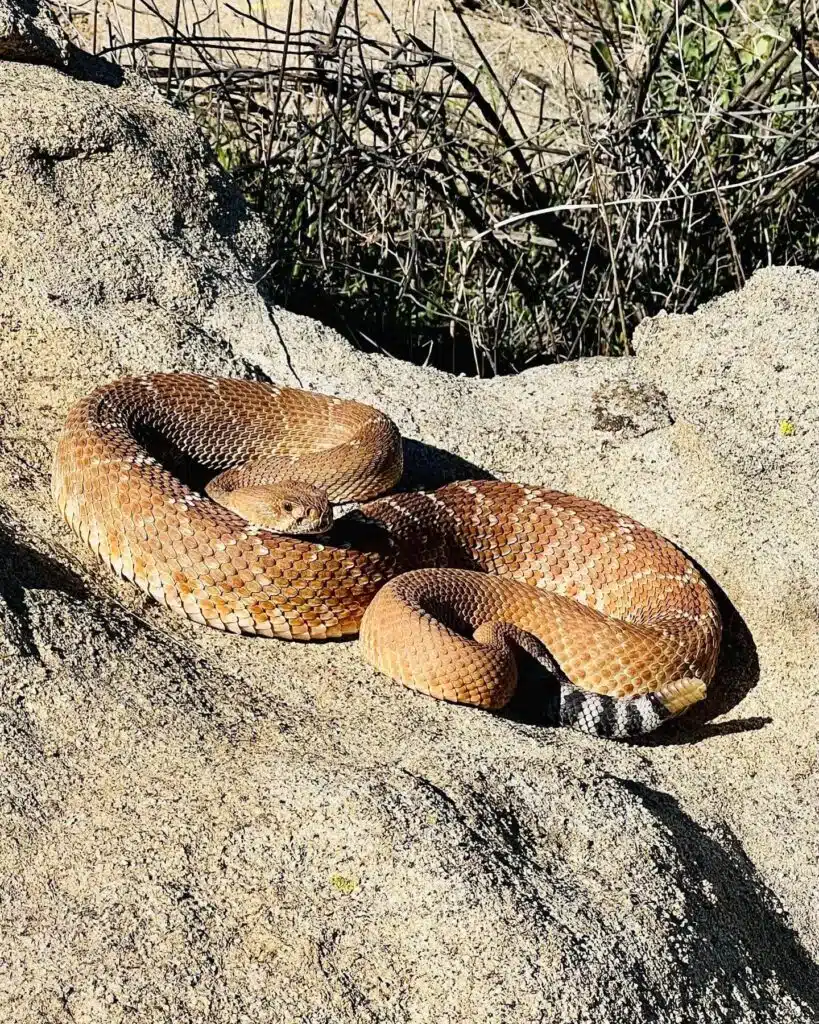
The Red Diamond Rattlesnake (Crotalus ruber) is a venomous pit viper, common in southwestern California and Baja California in Mexico. This large snake can grow to one hundred centimeters in length, though larger males have been recorded at more than one hundred and sixty-two centimeters.
The scales on the back of the snake comprise of twenty-nine rows. They are more common in coastal regions than in desert areas. Its venom is not as potent as other rattlesnakes, but it is still considered a medical emergency. A bite can be fatal without the right anti-venom treatment.
The red diamond rattlesnake is variable in color. They range from pink to red and tan to brown. They have distinct diamond-shaped patches on their backs, which have light edges. The underside is yellow and unmarked. There are black and white rings just before the rattle.
5. Scarletsnake
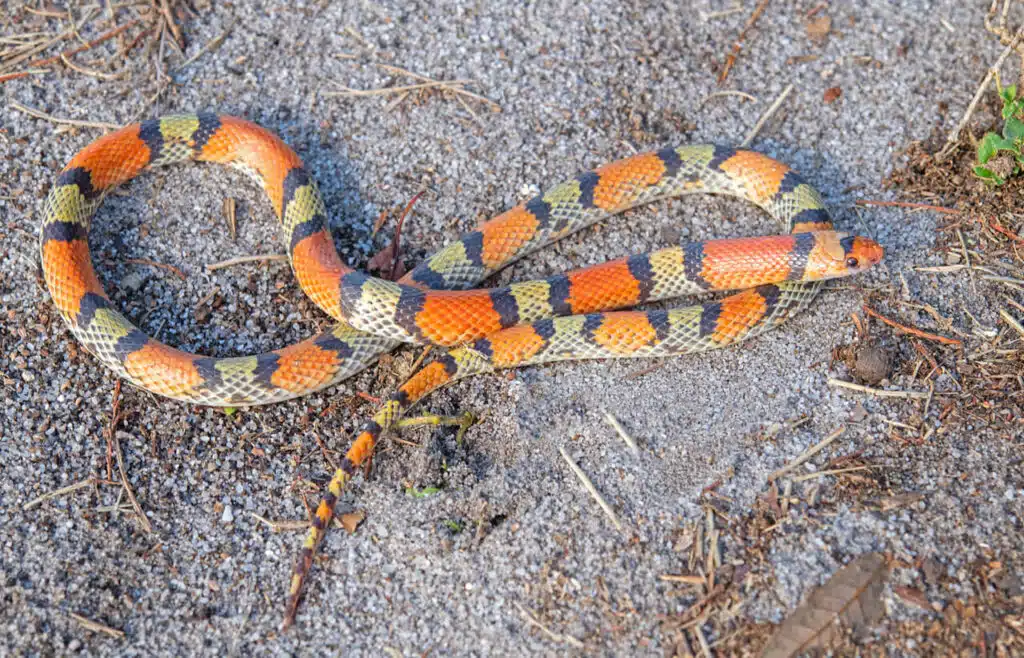
The Scarletsnake (Cemophora coccinea) is a non-venomous snake, belonging to the Colubridae family. It is native to the southeastern United States. This small snake grows to sixty-six centimeters in length.
They have a gray back with black-bordered yellow, white, orange, or red patches. The belly can be white or light gray. The patches on the back extend down the side of the body, which looks like rings or banding.
This snake is often confused with a venomous coral snake. They are only found in the United States where they prefer open forest areas with plenty of ground litter. This snake is non-venomous.
6. Great Plains Ground Snake
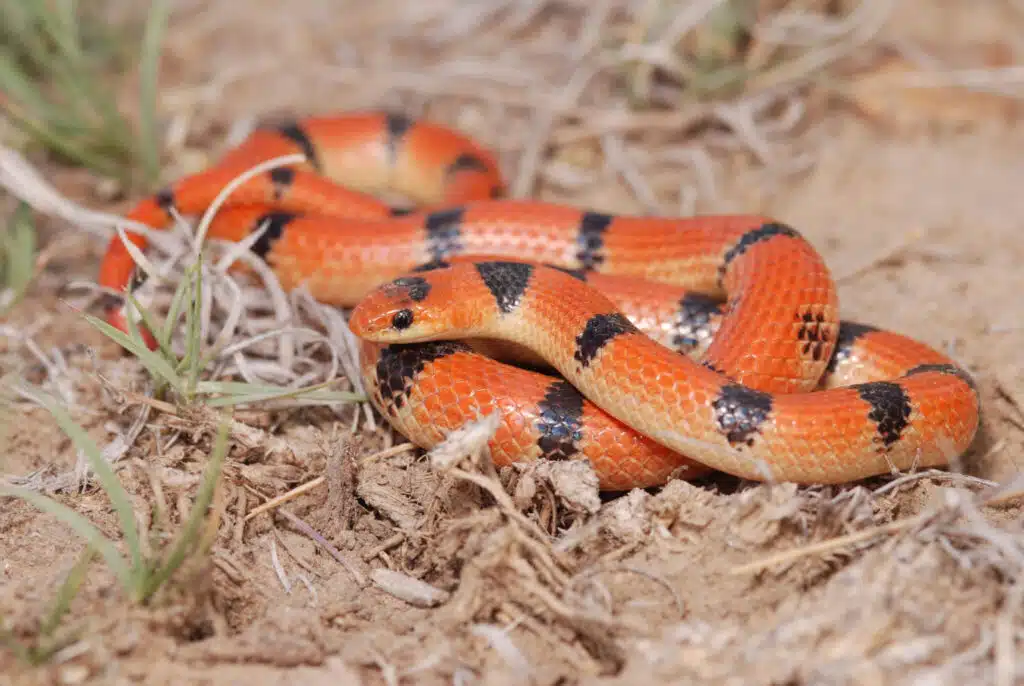
The Great Plains Ground Snake (Sonora episcopa) is varied in color and can be tan with red stripes to orange with a crossbar on the neck. The underside is cream. They prefer dry and rocky habitats.
There is not much known about this particular snake, but the shallow grooves on the rear teeth show it may produce mild venom, though it is not considered dangerous to humans.
7. Ground Snake
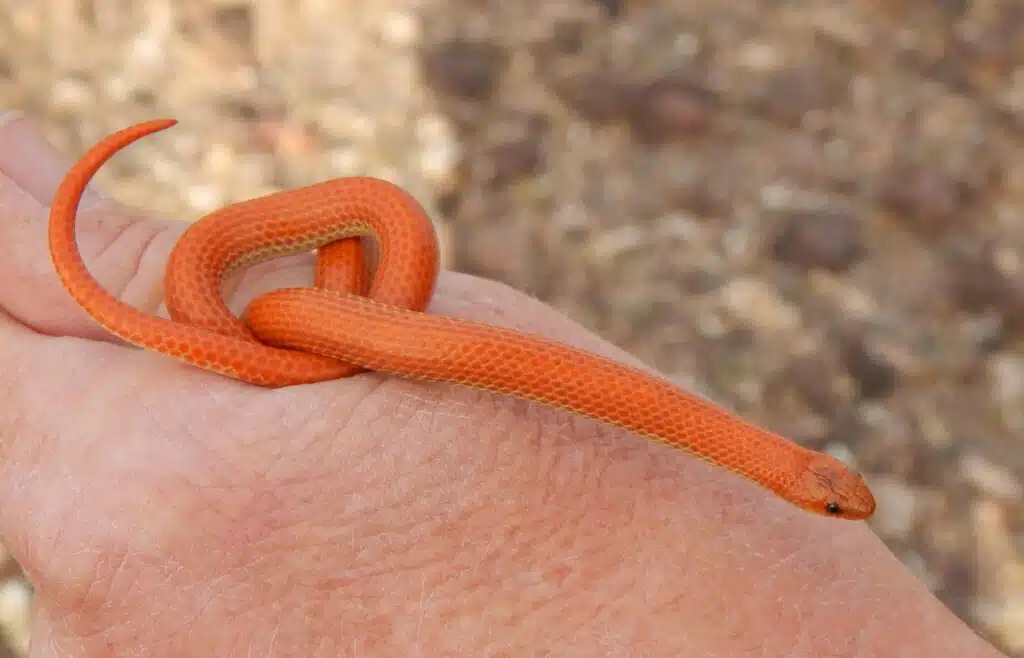
The Ground Snake (Sonora semiannulata) is a small and harmless snake, endemic to North America. It is often referred to as the common ground snake. The coloration and pattern vary from one individual to the next, even when they are in the same geographical area.
This snake can grow to forty-eight centimeters in length. Some are brown, others are orange, or red. There is black banding, and striping or they can be a solid color. The belly is white or gray with smooth scales, round pupils, and a small head.
This is a very secretive snake. It is nocturnal and seldom encountered, even though it is common throughout its range. Sometimes you may see one in a drainage ditch or on the roadside at night, as it forages for food.
8. Pine Woods Littersnake
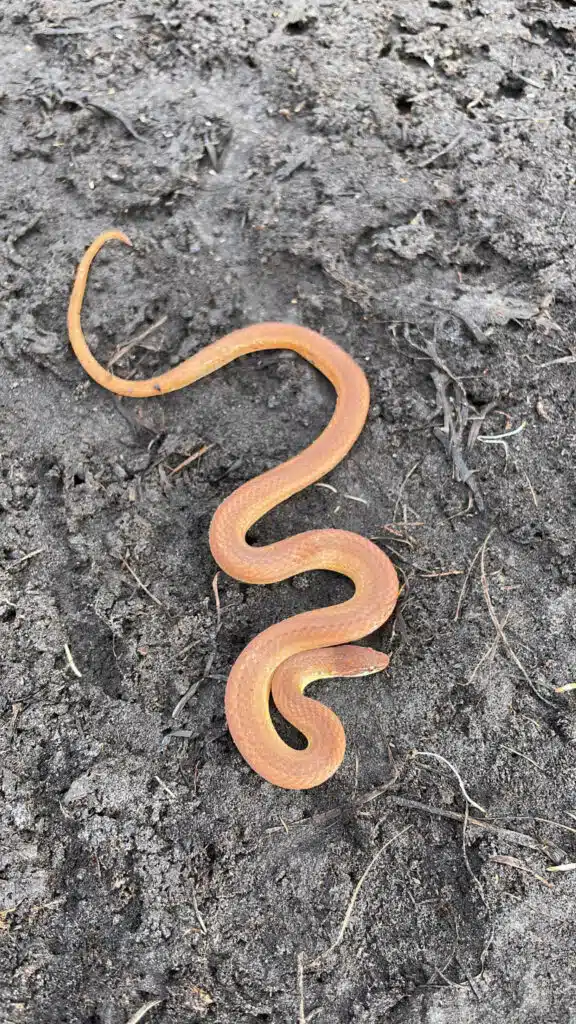
The Pine Woods Littersnake (Rhadinaea flavilata) is also referred to as the yellow-lipped snake. They are found in locations throughout the southeastern United States. It is mildly venomous with rear fangs, though it is not dangerous to humans.
This small dark orange, red-brown, or yellow-brown snake has a yellow underside. There is a dark stripe that runs right through the eye. Some have a light stripe down the center of the back.
This is a small snake that grows to thirty-three centimeters in length, which includes the tail. They prefer pine and mixed-pine hardwood forests. They are sometimes encountered in damp woodlands hiding under rotting stumps and logs, or under the bark.
9. Arizona Mountain Kingsnake
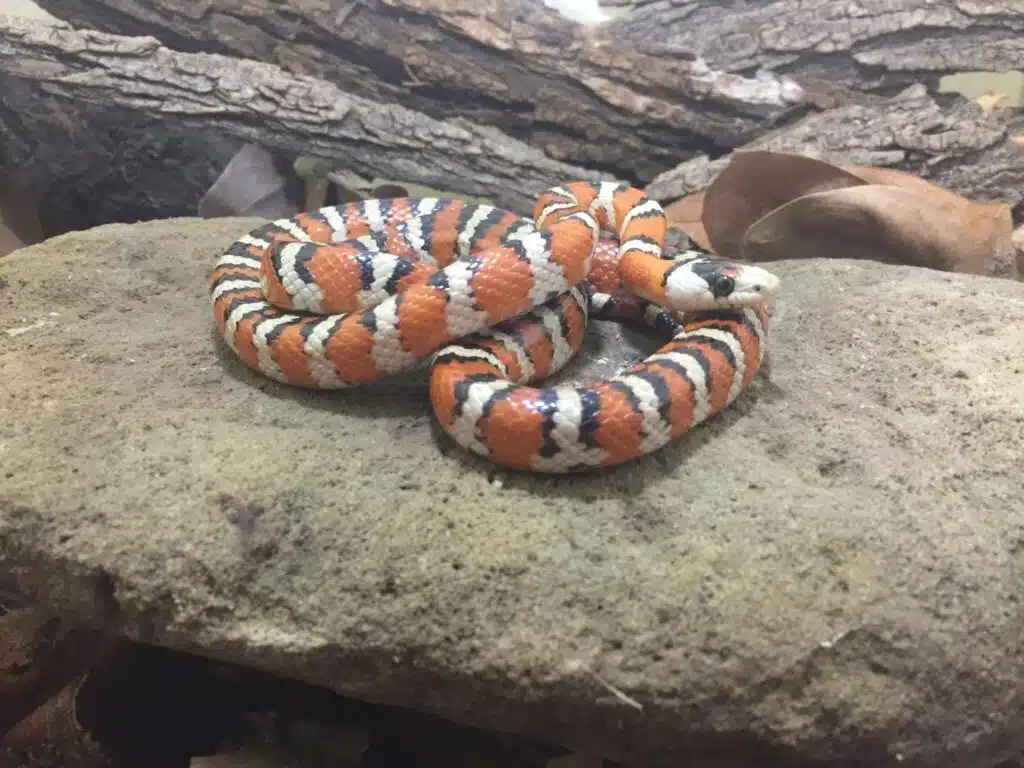
The Arizona Mountain Kingsnake (Lampropeltis pyromelana) is native to Arizona and can grow to ninety-one centimeters in length. It can be encountered from the northwestern corner of Arizona, through the central mountain ranges to the southeast.
This snake is found in a variety of habitats, including chaparral and conifer forests. They are often found close to springs or streams.
While this snake is harmless, it mimics the venomous coral snake and is often killed by mistake as a result. It is a dark brown or black snake with bands of yellow, white, orange, or cream which run around the body. The banding widens at the belly.
10. Gray-banded Kingsnake
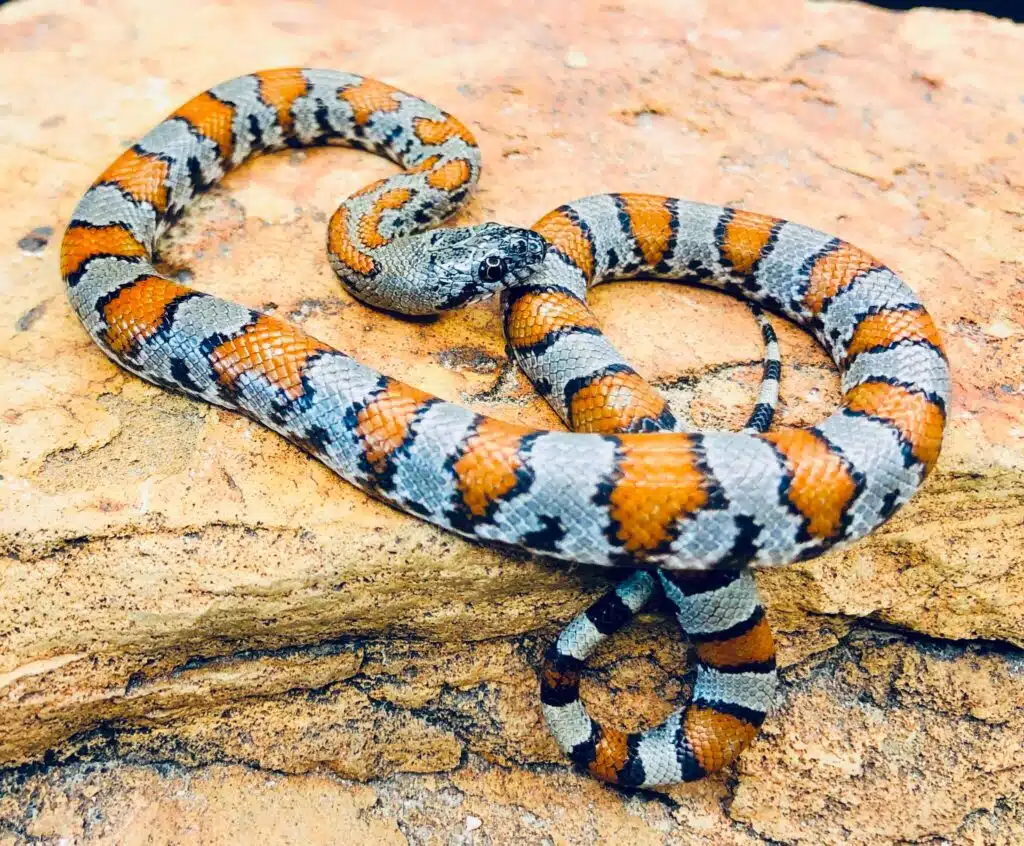
The Gray-banded Kingsnake (Lampropeltis alterna) is a non-venomous snake, belonging to the Colubridae family. It is endemic to the southwestern United States and Mexico. This snake can grow to one hundred and twenty centimeters in length, which includes the tail.
It has a wide head with large eyes. The coloration and pattern vary greatly based on the subspecies. One has a wide orange-red band, while the other has a thin orange-red band. They both are gray with white or back accents.
The gray-banded kingsnake can be found in northern Mexico, southern New Mexico, and southwestern Texas where it is associated with volcanic and limestone substrates.
11. Black Swampsnake
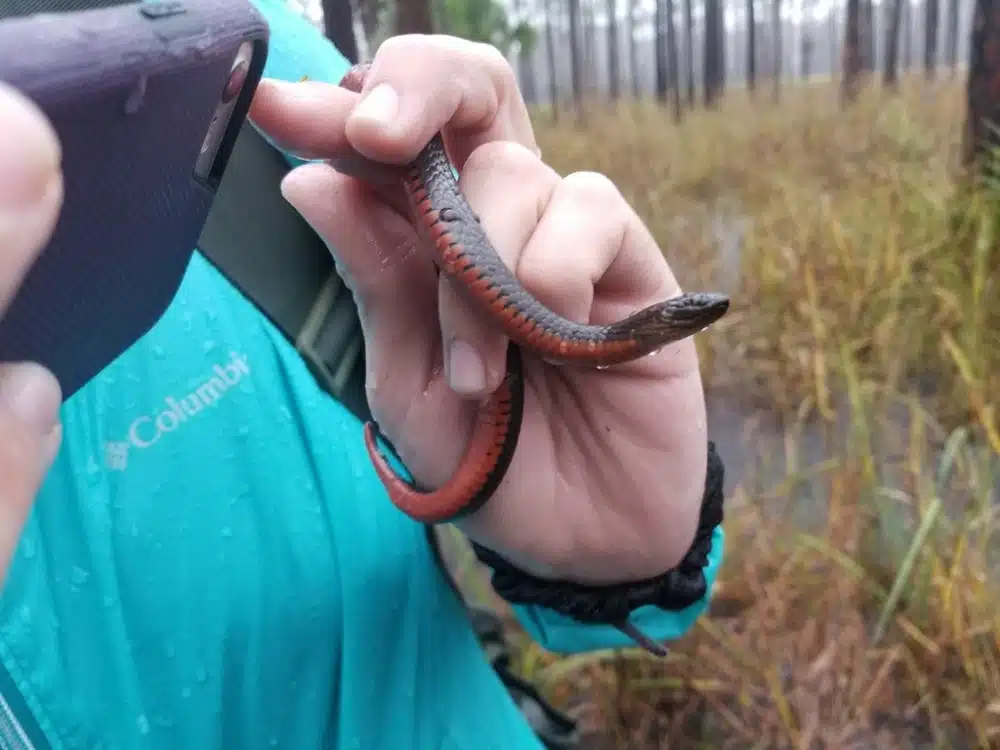
The Black Swampsnake (Liodytes pygaea) belongs to the Colubridae family. It is endemic to the southeastern United States. This snake prefers heavily vegetated swampland habitats.
You can identify this small snake for its thin body and length of around thirty-eight centimeters. They have a black back and a bright orange underside. It is entirely aquatic, spending its time hiding in the vegetation in cypress swamps.
12. Texas Scarletsnake
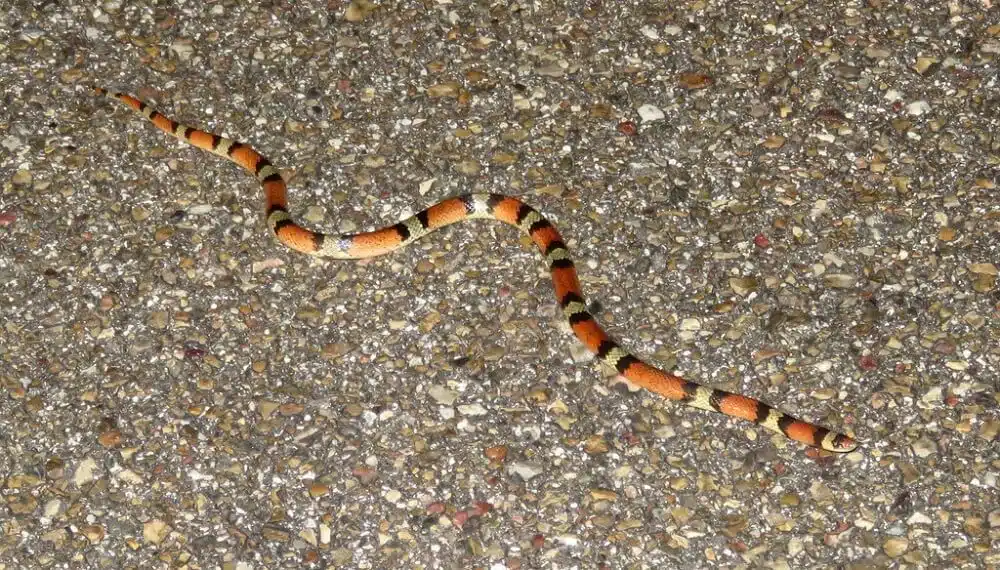
The Texas Scarletsnake (Cemophora lineri) is a non-venomous snake, belonging to the Colubridae family. It can grow to sixty-six centimeters in length and is gray or white with orange-red patches with black borders. The black borders do not join. The belly with gray or white.
This snake is secretive, spending the majority of its time underground. They prefer sandy habitats on the Gulf of Mexico coastline.
13. Milksnake
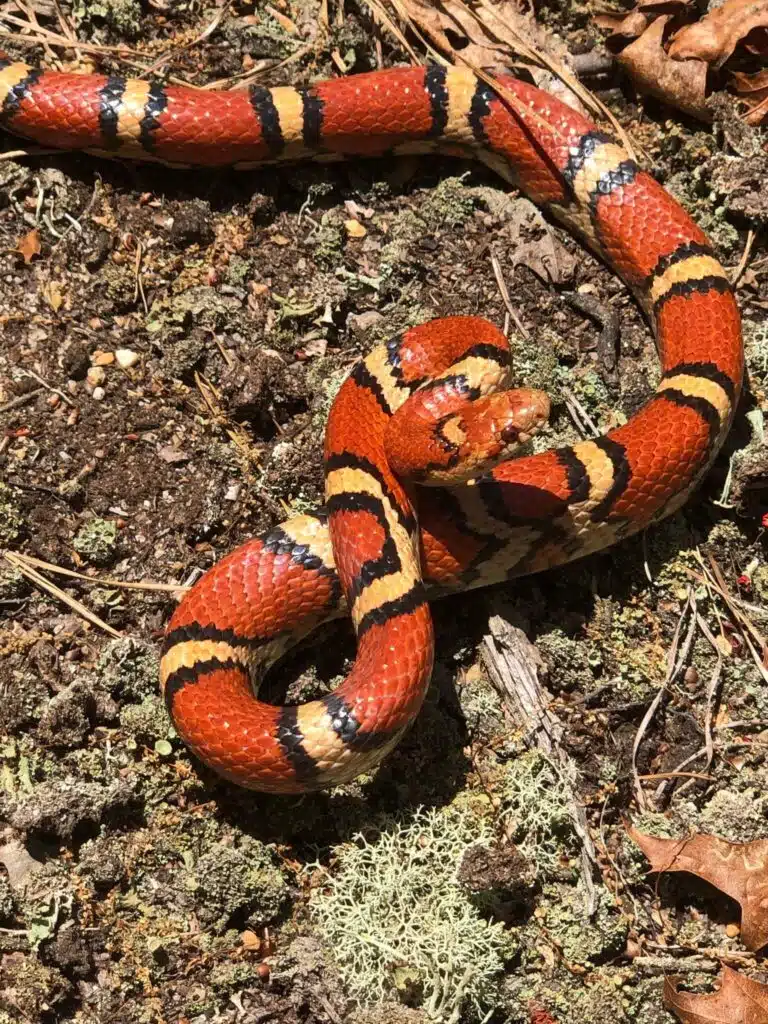
The Milksnake (Lampropeltis triangulum) is a kingsnake and is not venomous to humans. It prefers forest regions, though it can be encountered in farmlands, sandy dunes, rocky slopes, prairies, and swamps. It is known to move during winter to drier habitats to hibernate, moving back to the moist habitat for summer.
Milksnakes vary based on size. They can be thirty-six centimeters or they can be one hundred and eighty-three centimeters in length. Large adults can become bulky and weigh more than one thousand grams.
The male is larger than the female, but the female is bulkier. They have smooth scales that are shiny with alternating bands or white-black-red or red-black-yellow. Some have red/orange patches rather than banding. Some look similar to coral snakes.
Milksnakes and coral snakes have bands of black, red, and yellow, making it very hard to distinguish the two. Juvenile milk snakes tend to have more orange to their coloration than adults, which means they are often killed as people think they are the venomous copperhead.